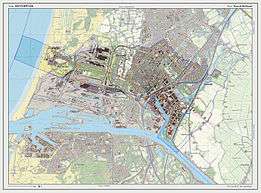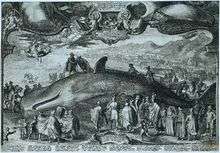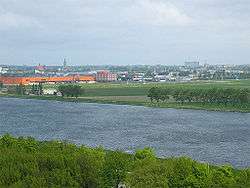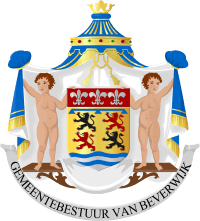Beverwijk
| Beverwijk | |||
|---|---|---|---|
| Municipality | |||
|
Beverwijk as seen from the North Sea Canal | |||
| |||
.svg.png) Location in North Holland | |||
| Coordinates: 52°29′N 4°39′E / 52.483°N 4.650°ECoordinates: 52°29′N 4°39′E / 52.483°N 4.650°E | |||
| Country | Netherlands | ||
| Province | North Holland | ||
| Government[1] | |||
| • Body | Municipal council | ||
| • Mayor | Han van Leeuwen (D66) | ||
| Area[2] | |||
| • Total | 20.09 km2 (7.76 sq mi) | ||
| • Land | 18.34 km2 (7.08 sq mi) | ||
| • Water | 1.75 km2 (0.68 sq mi) | ||
| Elevation[3] | 2 m (7 ft) | ||
| Population (May 2014)[4] | |||
| • Total | 40,049 | ||
| • Density | 2,184/km2 (5,660/sq mi) | ||
| Demonym(s) | Beverwijker | ||
| Time zone | CET (UTC+1) | ||
| • Summer (DST) | CEST (UTC+2) | ||
| Postcode | 1940–1949 | ||
| Area code | 251 | ||
| Website |
www | ||

Beverwijk (Dutch pronunciation: [ˌbeːvərˈʋɛi̯k]) is a municipality and a town in the Netherlands, in the province of North Holland. The town is located about 20 kilometres (12 mi) northwest of Amsterdam in the Randstad metropolitan area, north of the North Sea Canal very close to the North Sea coast. A railway tunnel and two motorway tunnels cross the canal between Beverwijk and the nearby city of Haarlem on the south bank.
Around 1640, a town called Beverwyck was founded in the Dutch colony of New Netherland. This town's modern name is Albany, New York.
Population centres
The municipality of Beverwijk consists of two cores, Beverwijk proper and Wijk aan Zee, 5 km (3.1 mi) to the west, right on the coast.
History

The name Beverwijk comes from Bedevaartswijk, meaning "pilgrimage neighbourhood". The town formed at the Saint Agatha Church which was a pilgrimage location in the Middle Ages. Allegedly Agatha of Sicily appeared there in the 9th century to a virgin from Velsen who was fleeing from the Count of Kennemerland.
In 1276 Beverwijk was granted market rights by Floris V, and in 1298 it was granted city rights by John I, both Counts of Holland.
During the 17th century wealthy merchants from Amsterdam built their estates, such as Huize Akerendam, Huize Westerhout, and Huize Scheijbeeck, in the scenic dunes surrounding Beverwijk.
Prior to the reclamation of the IJ Bay, the narrowest point in the North Holland peninsula was at Beverwijk. Therefore, a defensive line was built there in 1800 following the Battle of Castricum in 1799.
In 1944, during the Second World War, the Germans conducted a house-to-house raid in Beverwijk and Velsen-Noord, seizing nearly 500 persons as hostages to force the murderers of three collaborators to surrender themselves. In all, 63 of them never returned.
Around 1977, the first furniture stores opened along the Parallel Road, forming the first "furniture boulevard" in the Netherlands. By 1981, 10 businesses had been established there. South of the furniture boulevard, the Bazaar was introduced in 1980.
On March 23, 1997, Beverwijk was the location of a clash of two football firms. Supporters of the Dutch football team AFC Ajax met with Feyenoord supporters in what has come to be known as the "Battle of Beverwijk". During this incident, one Ajax supporter was beaten to death.
Since 1997, Special Needs Judo Foundation has organised its annual OBG (Open Beverwijk G-judo) tournament in Sporthal De Walvis, featuring over 1000 special needs judoka from all over the world. The tournament takes place every year in April.
Local government
The municipal council of Beverwijk consists of 25 seats, which are divided as follows:
- PvdA - 10 seats
- CDA - 5 seats
- VVD - 4 seats
- GroenLinks - 3 seats
- Democraten Beverwijk - 2 seats
- Gemeentebelangen - 1 seats
Notable residents
- Jan Cornelisz Vermeyen (1500-1559), painter
- Thomas Wijck (1616-1677), painter
- Ab Geldermans (born 1935), cyclist winner of Luik-Bastenaken-Luik in 1960. Dutch champion in 1962
- Henk Tijms (born 1944), professor
- Wouly de Bie (born 1958), water polo player
- Ilse Huizinga (born 1966), singer
- Dorus de Vries (born 1980), football (soccer) goalkeeper
- Niki Terpstra (born 1984), cyclist
- Stefan Struve (born 1988), mixed martial artist
- Paul de Lange, football (soccer) player
- Willem de Rooij, (born in 1969), artist
- Arthur Numan, (born in 1969), football (soccer) player
Transport
References
- ↑ "College van B en W" [Board of mayor and aldermen] (in Dutch). Gemeente Beverwijk. Retrieved 24 February 2014.
- ↑ "Kerncijfers wijken en buurten" [Key figures for neighbourhoods]. CBS Statline (in Dutch). CBS. 2 July 2013. Retrieved 12 March 2014.
- ↑ "Postcodetool for 1948LC". Actueel Hoogtebestand Nederland (in Dutch). Het Waterschapshuis. Retrieved 24 February 2014.
- ↑ "Bevolkingsontwikkeling; regio per maand" [Population growth; regions per month]. CBS Statline (in Dutch). CBS. 26 June 2014. Retrieved 24 July 2014.
External links
 Media related to Beverwijk at Wikimedia Commons
Media related to Beverwijk at Wikimedia Commons- Official website
 |
Heemskerk |  | ||
| North Sea | |
Zaanstad | ||
| ||||
| | ||||
| Velsen |



